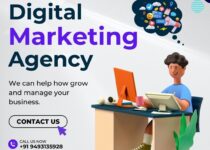Mastering the Digital Realm: A Deep Dive into the Transformative Landscape of Modern Marketing
In the rapidly evolving landscape of the Internet, businesses constantly seek innovative ways to connect with their target audience. Traditional marketing techniques can no longer reach a vast, diverse online consumer base. This is forcing business owners to enter the new era of digital marketing. A transformative approach that has revolutionized the way companies promote their goods.
Defining Digital Marketing
Digital marketing encompasses a wide range of strategies and tactics for online outreach. These strategies include digital channels, platforms, and technologies to reach, engage, and convert potential customers. Unlike traditional marketing, which relies on offline mediums, digital marketing operates virtually. This allows businesses to create personalized and highly targeted marketing campaigns using robust online tools.
The Core Components of Digital Marketing
Search Engine Optimization (SEO): SEO is the foundation of many digital marketing campaigns. It aims to optimize a website’s visibility on search engine result pages (SERPs). Businesses can improve their organic ranking and attract more visitors by employing relevant keywords, creating high-quality content, and earning backlinks from other reputable websites.
Content Marketing: Content is king in digital marketing and one of the best ways to reach customers. Content marketing involves creating and distributing content. But not any content will do! It has to be valuable, relevant, and consistent content to attract and retain a defined audience. Blogs, articles, videos, and social media posts are some of the popular forms. Each piece is meant to engage consumers and build brand authority.
Social Media Marketing: With billions of users online spending hours on their favorite platforms, it’s easy to see why social media is so important. Social media marketing involves creating and sharing content to build engagement. This helps to foster brand loyalty and drive sales.
Email Marketing: Despite the rise of newer marketing channels, email marketing remains a powerful social of traffic. It’s a potent tool for nurturing leads and converting them into customers. Businesses can deliver personal content, offers, and more through targeted email marketing campaigns.
Pay-Per-Click (PPC) Advertising: A method of advertisement where a business bid on keywords. Once a business wins, its ads appear on search engines or other platforms when users search for those terms. Advertisers are only charged once their ads get clicked, making PPC a cost-effective way to drive traffic and conversions.
Influencer Marketing: A form of marketing that leverages the influence of other individuals. These people typically have more significant followings on social media or other platforms, including email lists. By collaborating, a business can reach a broader audience and build credibility among its target market.
Affiliate Marketing: Affiliate marketing is a performance-based strategy. Like Influence marketing, affiliate marketing involves employing individuals to promote your goods. Many influencers also engage in affiliate marketing for at least one company. The most significant difference is that affiliates (partners) are rewarded for driving traffic or sales to a business website. At the same time, influencers get paid before marketing a business’s product.
Analytics and Data-Driven Decision-Making: I advise using this with everything mentioned thus far. Marketers can track campaign performance by gathering vast amounts of data and analytics. This gives marketers an insight into their targeted audience’s needs and wants to improve their campaigns.
The Advantages of Digital Marketing
Cost-Effectiveness: Digital marketing is often more affordable than traditional marketing methods. This makes it accessible to businesses of all sizes, including startups and small enterprises.
Global Reach: The internet knows no boundaries. This allows businesses to expand their reach beyond local marketers and target audiences worldwide.
Personalization: Digital marketing enables businesses to create personalized experiences. This increases the chance of engagement and conversions.
Real-time Metrics: Digital marketing offers real-time tracking and analytics, unlike traditional marketing. This is huge for businesses as it enables marketers to monitor the effectiveness of their campaigns and make adjustments on the fly.
Higher Engagement: Engagement and social sharing options in digital marketing encourage higher engagement rates. This frequently allows your content to reach a bigger audience with one piece of content. Engagement also plays a significant factor in running ads on social media. With more engagement, you collect more data, and more people see your ad. Social media ads offer more for your buck than traditional static ads.
In conclusion:
In today’s interconnected world, digital marketing has become an indispensable tool. Through its diverse strategies and platforms, digital marketing empowers companies to connect with their target audience, build brand awareness, and foster customer relationships. As such, digital marketing will continue to advise as technology evolves. Failing to embrace this dynamic approach will destroy business as it will be left behind as a relic of the past.
P.S. This will be my last post before the New Year, but I’ll return later. With that said, Merry Christmas and Happy Holidays 🙂


